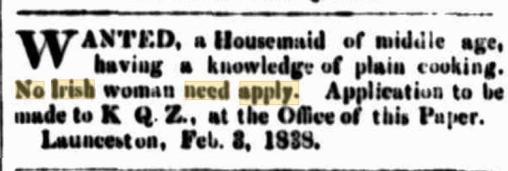
Cornwall Chronicle (Launceston, Tasmania), 3 February 1838. Source: Trove
Clíona Purcell ~ Aisilyn Guivens ~ Joshua Tomiak
Much has been written about anti-Irish discrimination across several locations worldwide and, as such, Australia is no exception. However, discrimination against the Irish in nineteenth-century Australia was far less pronounced than its counterparts.
There were several reasons for the treatment of the Irish migrants in colonial Australia. The prejudice owed its roots to a wider cultural perception of the Irish as being poor, uneducated and violently inclined. Some of the earliest arrivals to the penal colonies from Ireland had been involved in the 1798 rebellion of the United Irishmen, and were responsible for the Castle Hill rebellion of 1804.[1] Further ‘Fenian’ activity through the century, such as an attempted assassination of Prince Alfred in 1868, further contributed to this attitude and led to prejudice against the Irish community as a whole. This manifested in many ways, including restricting Irish migration to Australia during the nineteenth century.[2]
The many convict ships transporting Irish convicts and settlers also brought their Roman Catholic faith. Along with this came tension with the English immigrants, some of whom despised the Irish, their most distinct difference being religion. The tumultuous journey of the Irish continued as they faced religious discrimination by the English settlers, wanting a pure English society. Officials restricted them in regards to land-ownership, voting, education, government positions, and religious practice.[3]
Catholic priests, uncommon in New South Wales in the early nineteenth century, were discouraged – and in some cases prevented – from constructing Catholic churches and schools. Many children were forced to attend Protestant schools as limited options for Catholics were provided. With the regulations enforced by officials, non-Catholics labelled the Irish as being evil, uneducated and improper citizens. However, the Irish quickly gained a foothold due to an increasing number of educated immigrants arriving in Australia who combated – as evidenced in many contemporary newspapers – the anti-Catholic ideology that had formed in New South Wales.[4]
The second half of the nineteenth century saw two different and yet coherent developments regarding the Irish migrants’ experience of discrimination in the Australian colonies. On the one hand, the Irish became increasingly part of the emerging ‘Australian’ society. On the other hand, there was a new ethnic group that suffered a much stronger form of legislated discrimination.

Monster meeting of miners, Temora, 1883. Source: Migration Heritage Centre NSW
The Chinese, by comparison with the European settlers, were ‘strange’ in everything, from their looks to how they lived, their language and food.
Letters to the editors of Irish newspapers in Australia, like the Freeman’s Journal (Sydney, New South Wales), show that despite their own treatment, the Irish demanded that Australia remain a ‘British colony’.
The new ‘enemy’, the Chinese migrant, helped to unite the ‘British’ citizens of Australia in a way that freed the Irish from discrimination, and that laid the way for the ‘White Australia’ policy of the following decades.
REFERENCES
[1] Raelene Francis, ‘Green demons: Irish-Catholics and Muslims in Australian history’, Islam and Christian–Muslim Relations, 22.4 (2011), p. 444.
[2] Eric Richards, ‘Irish life and progress in Colonial South Australia’, Irish Historical Studies, 27.107 (1991), p. 220.
[3] ‘Sketches of the early history of Australia’, Fitzroy City Press, 16 November 1912. (http://trove.nla.gov.au/newspaper/article/65680393?searchTerm=Catholic%20Clergy%201820&searchLimits=l-australian=y) (26 March 2017)
[4] Ann Daniel, ‘Undermining British Australia: Irish lawyers and the transformation of English law in Australia,’ in Studies: An Irish Quarterly Review, 84.333 (1995), pp 61-70.